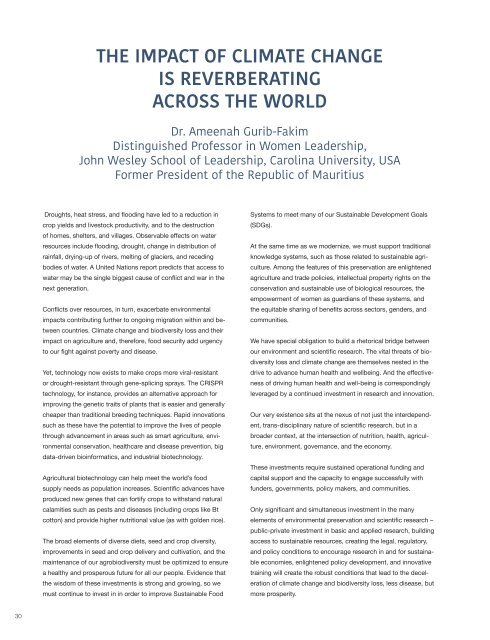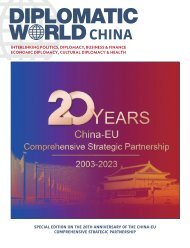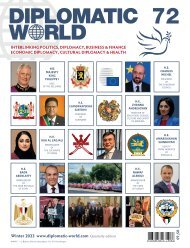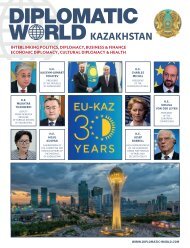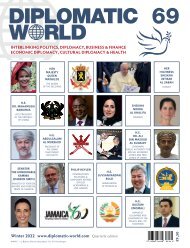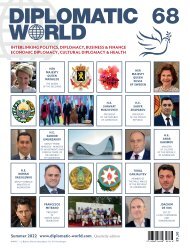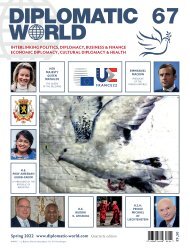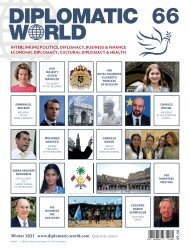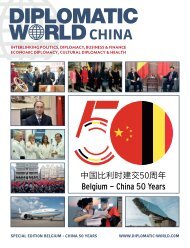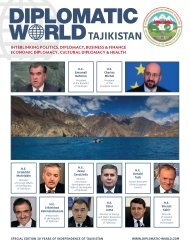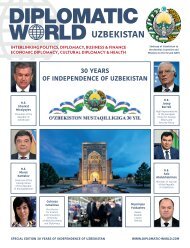Diplomatic World 67
You also want an ePaper? Increase the reach of your titles
YUMPU automatically turns print PDFs into web optimized ePapers that Google loves.
THE IMPACT OF CLIMATE CHANGE<br />
IS REVERBERATING<br />
ACROSS THE WORLD<br />
Dr. Ameenah Gurib-Fakim<br />
Distinguished Professor in Women Leadership,<br />
John Wesley School of Leadership, Carolina University, USA<br />
Former President of the Republic of Mauritius<br />
The world is tackling the challenges of maintaining biodiversity<br />
and decelerating climate change, but the trade-offs that they require<br />
inevitably pit one country’s interests against another’s. We<br />
must bring all possible human and financial resources to bear on<br />
fighting climate change, protecting our biodiversity and creating<br />
a better Earth for peoples everywhere.<br />
This challenge is not easy: reaching it depends on the contributions<br />
of highly-skilled individuals from everywhere in the world,<br />
political courage and foresight, and creative, ambitious innovation.<br />
But it can be done because it must be done. Our ability<br />
to create a sustained future for ourselves is not optional: it is<br />
existential.<br />
Droughts, heat stress, and flooding have led to a reduction in<br />
crop yields and livestock productivity, and to the destruction<br />
of homes, shelters, and villages. Observable effects on water<br />
resources include flooding, drought, change in distribution of<br />
rainfall, drying-up of rivers, melting of glaciers, and receding<br />
bodies of water. A United Nations report predicts that access to<br />
water may be the single biggest cause of conflict and war in the<br />
next generation.<br />
Conflicts over resources, in turn, exacerbate environmental<br />
impacts contributing further to ongoing migration within and between<br />
countries. Climate change and biodiversity loss and their<br />
impact on agriculture and, therefore, food security add urgency<br />
to our fight against poverty and disease.<br />
Yet, technology now exists to make crops more viral-resistant<br />
or drought-resistant through gene-splicing sprays. The CRISPR<br />
technology, for instance, provides an alternative approach for<br />
improving the genetic traits of plants that is easier and generally<br />
cheaper than traditional breeding techniques. Rapid innovations<br />
such as these have the potential to improve the lives of people<br />
through advancement in areas such as smart agriculture, environmental<br />
conservation, healthcare and disease prevention, big<br />
data-driven bioinformatics, and industrial biotechnology.<br />
Agricultural biotechnology can help meet the world’s food<br />
supply needs as population increases. Scientific advances have<br />
produced new genes that can fortify crops to withstand natural<br />
calamities such as pests and diseases (including crops like Bt<br />
cotton) and provide higher nutritional value (as with golden rice).<br />
The broad elements of diverse diets, seed and crop diversity,<br />
improvements in seed and crop delivery and cultivation, and the<br />
maintenance of our agrobiodiversity must be optimized to ensure<br />
a healthy and prosperous future for all our people. Evidence that<br />
the wisdom of these investments is strong and growing, so we<br />
must continue to invest in in order to improve Sustainable Food<br />
Systems to meet many of our Sustainable Development Goals<br />
(SDGs).<br />
At the same time as we modernize, we must support traditional<br />
knowledge systems, such as those related to sustainable agriculture.<br />
Among the features of this preservation are enlightened<br />
agriculture and trade policies, intellectual property rights on the<br />
conservation and sustainable use of biological resources, the<br />
empowerment of women as guardians of these systems, and<br />
the equitable sharing of benefits across sectors, genders, and<br />
communities.<br />
We have special obligation to build a rhetorical bridge between<br />
our environment and scientific research. The vital threats of biodiversity<br />
loss and climate change are themselves nested in the<br />
drive to advance human health and wellbeing. And the effectiveness<br />
of driving human health and well-being is correspondingly<br />
leveraged by a continued investment in research and innovation.<br />
Our very existence sits at the nexus of not just the interdependent,<br />
trans-disciplinary nature of scientific research, but in a<br />
broader context, at the intersection of nutrition, health, agriculture,<br />
environment, governance, and the economy.<br />
These investments require sustained operational funding and<br />
capital support and the capacity to engage successfully with<br />
funders, governments, policy makers, and communities.<br />
Only significant and simultaneous investment in the many<br />
elements of environmental preservation and scientific research –<br />
public-private investment in basic and applied research, building<br />
access to sustainable resources, creating the legal, regulatory,<br />
and policy conditions to encourage research in and for sustainable<br />
economies, enlightened policy development, and innovative<br />
training will create the robust conditions that lead to the deceleration<br />
of climate change and biodiversity loss, less disease, but<br />
more prosperity.<br />
Foreword: The Impact of Climate Change is Reverberating<br />
Across the <strong>World</strong><br />
Photo: Shuttterstock<br />
30 31


